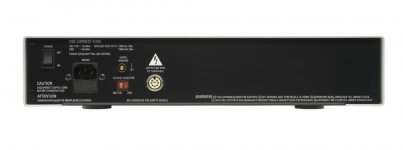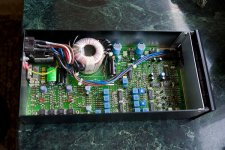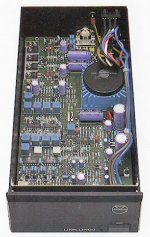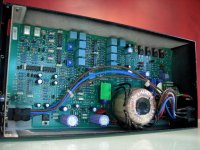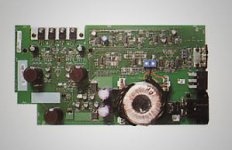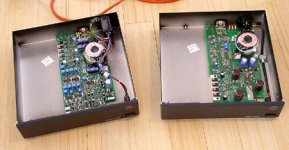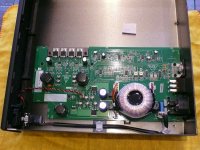LINGO vs. LINGO-II and LINGO-III - where are the differences ??
At starting this thread I look only to the first version of Linn's LINGO.
There are at whole three versions of this synchronus motor control device (MK-II and MK-III resp. Lingo-2 and Lingo-3).
Who knows the exactly differences compared with the first version?
This URLs don't provide the wished informations:
Lingo vs Lingo II
Naim Audio Forums: Lingo I --> Lingo II ?
http://small.linncdn.com/product-catalogue/documents/Linn_Lingo_Owners_Manual-DE.pdf
Who know more?
Thank you for advices.
At starting this thread I look only to the first version of Linn's LINGO.
There are at whole three versions of this synchronus motor control device (MK-II and MK-III resp. Lingo-2 and Lingo-3).
Who knows the exactly differences compared with the first version?
This URLs don't provide the wished informations:
Lingo vs Lingo II
Naim Audio Forums: Lingo I --> Lingo II ?
http://small.linncdn.com/product-catalogue/documents/Linn_Lingo_Owners_Manual-DE.pdf
Who know more?
Thank you for advices.
I doubt the performance has changed one bit.
They had to put it in a fancy new box, to match the other bits.
jeff
Some Url's and images - found by image search - concerning varios versions:
Linn Lingo ($1600) vs. Naim Audio Armageddon ($1550):
Listening #26 | Stereophile.com
LP12/Lingo-I measurements:
Linn Sondek LP12 turntable with Lingo power supply Measurements | Stereophile.com
Linn Sondek LP12 turntable with Lingo power supply | Stereophile.com
Various Lingo Versions:
Valhalla with electronic 45 rpm?
An image from inside of Lingo-III I don't find.
Linn Lingo ($1600) vs. Naim Audio Armageddon ($1550):
Listening #26 | Stereophile.com
LP12/Lingo-I measurements:
Linn Sondek LP12 turntable with Lingo power supply Measurements | Stereophile.com
Linn Sondek LP12 turntable with Lingo power supply | Stereophile.com
Various Lingo Versions:
Valhalla with electronic 45 rpm?
An image from inside of Lingo-III I don't find.
Attachments
Last edited:
spectrum of 1kHz sinewave by two different "LINGO" devices
go to Fig. 1 and Fig. 2 (1990 sample vs. 2003 sample) to this URL:
Linn LP Playing System Measurements | Stereophile.com
BTW - nearly perfect looks Fig. 3 from the Pioneer model PL-L1000
completely paper:
Linn LP Playing System | Stereophile.com
go to Fig. 1 and Fig. 2 (1990 sample vs. 2003 sample) to this URL:
Linn LP Playing System Measurements | Stereophile.com
BTW - nearly perfect looks Fig. 3 from the Pioneer model PL-L1000
completely paper:
Linn LP Playing System | Stereophile.com
Last edited:
Interesting, the Linn has the narrower peak, but also has secondary peaks at -40db and also a higher overall noise floor. IME the Linn looks and sounds good until you hear what better really sounds like, then you realise how much of the Linn sound comes from the interaction of the suspension stability and the motor drive.
Which effects cause these peaks at a listening test ?Interesting, the Linn has the narrower peak, but also has secondary peaks at -40db and also a higher overall noise floor. IME the Linn looks and sounds good until you hear what better really sounds like, then you realise how much of the Linn sound comes from the interaction of the suspension stability and the motor drive.
Maybe a more harsh sonic transmission ?
Or more the same effects as with flutter at tapes.
I can't prove it but I think those first peaks at either side come from the suspension being set in motion by the belt drive, they likely equate to a side-to-side wobble.
The peaks at +/- 50hz and 100hz from the fundamental test tone frequency come from the frequency of the mains and are break through into the drive system. This I have tested, you just swap the motor for the same motor with a different size pulley, (ie Linn for Kuzma) the fundamental will be different due to pulley size but those peaks still occur at +/- 50hz and 100hz just the same. They don't sync with the number of poles in the motor or the rpm of the motor so they very probably come from the mains frequency output by the psu.
The effect of these peaks is harder to pin down. I think the 'musical' feel of the Lp12 comes from the narrow shoulders on the steep slope of the graph, it is these that give the LP12 a lot of its delivery, the way it 'gallops' along, its sense of timing.
The +/- mains frequency multiple junk is pretty low level. I wonder if anything can be directly attributed to it.
The peaks at +/- 50hz and 100hz from the fundamental test tone frequency come from the frequency of the mains and are break through into the drive system. This I have tested, you just swap the motor for the same motor with a different size pulley, (ie Linn for Kuzma) the fundamental will be different due to pulley size but those peaks still occur at +/- 50hz and 100hz just the same. They don't sync with the number of poles in the motor or the rpm of the motor so they very probably come from the mains frequency output by the psu.
The effect of these peaks is harder to pin down. I think the 'musical' feel of the Lp12 comes from the narrow shoulders on the steep slope of the graph, it is these that give the LP12 a lot of its delivery, the way it 'gallops' along, its sense of timing.
The +/- mains frequency multiple junk is pretty low level. I wonder if anything can be directly attributed to it.
Turntable Motor Control Unit for Transformators for Voltage and 50 to 60Hz Conversion
What I must do to modify the schematic from post #1 (Valhalla/Lingo) in such kind, that I can drive a mains transformer for medium power between 50VA and 500 VA instead a synchronous motor?
I need it for a required 60 Hz oprating by certainly audio components for the US marked. Krell's HTS5.1 or Sunfire Theatre Grand Theatre are examples.
Various power amp models from Mark Levinson uses power amps in that kind to create a high-purity sine wave for the actually mains transformer of the amp.
Thank you for advices
What I must do to modify the schematic from post #1 (Valhalla/Lingo) in such kind, that I can drive a mains transformer for medium power between 50VA and 500 VA instead a synchronous motor?
I need it for a required 60 Hz oprating by certainly audio components for the US marked. Krell's HTS5.1 or Sunfire Theatre Grand Theatre are examples.
Various power amp models from Mark Levinson uses power amps in that kind to create a high-purity sine wave for the actually mains transformer of the amp.
Thank you for advices
Last edited:
I tried the following experiment with promising results several years ago but abandoned my LP12 after rebuilding my Garrard 301.
Create a 60Hz (or 50Hz depending on the pulley) .wav file using Audacity and save this to a good quality MP3 player / CD rom etc. Play the file into a preamplifier and power amplifier that is capable of driving a step up transformer. (If memory serves me right, I had wired a 12V secondary transformer as a step up device to get 80-100VAC @ 60Hz)
You can adjust the output voltage level by changing the volume and find the optimum low noise point this way. You can also compensate for speed errors by creating files that are slightly faster than 60Hz (I created a series of tracks at 60.1Hz, 60.2Hz etc)
As mentioned previously, Audacity gives one the ability to create multiple tracks and one can manually create harmonic frequencies at different levels and play these back via a second channel and mix the signals in the preamp. One could even take this concept further by creating two sine waves at pre-determined phase angles and drive the motor windings without a phase shift capacitor. (not recommended as this could fry your amplifier)
I used a Rotel RB 900bx power amp and a RC970 preamp and recall that the power amp ran very hot so more work was needed in this area - perhaps a class D amp or different step up transformer?
I destroyed my Rotel power amp (unrelated experiment!) a few years ago and can't re-run this test as a result but I would be interested to find out if this approach offers any improvements over the traditional oscillator circuit. I am willing to bet that this option is not nearly as bad as the rf hash creating Valhalla board and may be an improvement on the 'Geddon scheme since the turntable can now be fed with a cleaner supply.
Create a 60Hz (or 50Hz depending on the pulley) .wav file using Audacity and save this to a good quality MP3 player / CD rom etc. Play the file into a preamplifier and power amplifier that is capable of driving a step up transformer. (If memory serves me right, I had wired a 12V secondary transformer as a step up device to get 80-100VAC @ 60Hz)
You can adjust the output voltage level by changing the volume and find the optimum low noise point this way. You can also compensate for speed errors by creating files that are slightly faster than 60Hz (I created a series of tracks at 60.1Hz, 60.2Hz etc)
As mentioned previously, Audacity gives one the ability to create multiple tracks and one can manually create harmonic frequencies at different levels and play these back via a second channel and mix the signals in the preamp. One could even take this concept further by creating two sine waves at pre-determined phase angles and drive the motor windings without a phase shift capacitor. (not recommended as this could fry your amplifier)
I used a Rotel RB 900bx power amp and a RC970 preamp and recall that the power amp ran very hot so more work was needed in this area - perhaps a class D amp or different step up transformer?
I destroyed my Rotel power amp (unrelated experiment!) a few years ago and can't re-run this test as a result but I would be interested to find out if this approach offers any improvements over the traditional oscillator circuit. I am willing to bet that this option is not nearly as bad as the rf hash creating Valhalla board and may be an improvement on the 'Geddon scheme since the turntable can now be fed with a cleaner supply.
I currently run a Berger Lahr permanent magnet synchronous motor in a similar fashion. I use 2 20:1 transformers driven by a T-amp; it was necessary to add 4 ohms of resistors to the primary(amp) sides of the transformers, as without them the amp shut down almost immediately. This is unsurprising, as without resistors, the load is nearly a dead short(very low DC resistance)!
No capacitor is needed, as two 60hz waves can be outputted as left and right channels; and the phase angle can be manipulated, which has a significant effect on operation.
I initially used Audacity, but switched to a program called Cognaxon, a two channel frequency generator, which allows better control over relative level and phase; in fact the desired phase shift can be entered numerically- believe it or not, my current shift is 90.08 degrees!
I use this directly off a laptop, as I found that moving to a .wav file and burning a CDROM gave inferior results- implying, I think, that digital conversions have phase shifts to which these motors are sensitive(and not only the motors-our ears also, I suspect).
Cognaxon doesn't save anything, so it has to be set up everytime the computer is restarted, but this is fairly quick. A volt meter is needed to set the relative levels, these can be set within about 0.3 volts.
Obviously, not a permanent set up, but it's a good experimental rig, and reasonably cheap, below $100; the largest expense is the the transformers, mine were about $35 ea. IIRC. They are instrument/control transformers for use in applications where it's required to drop 480V power to 24V for a control circuit, for example. In this application, of course, the transformers are used backwards, to step up, not down. Any electrical supply vendor can supply them.
The harmonics tricks(for which I don't think Cognaxon would help you, you would need Audacity or equivalent) I haven't gotten into, other than to confirm that adding a 3rd harmonic(180hz) to a 60hz Audacity file flattens the peak, which may be helpful. i believe Mark Kelly has had success with this, though i don't know if he uses computer files.
Currently, i just acquired a Miracord 10H(for hysteresis) motor, which turns out to be a Papst 3 phase, wired delta, so I'm thinking about how to run that of a computer file...will need another transformer, and a surround receiver...
No capacitor is needed, as two 60hz waves can be outputted as left and right channels; and the phase angle can be manipulated, which has a significant effect on operation.
I initially used Audacity, but switched to a program called Cognaxon, a two channel frequency generator, which allows better control over relative level and phase; in fact the desired phase shift can be entered numerically- believe it or not, my current shift is 90.08 degrees!
I use this directly off a laptop, as I found that moving to a .wav file and burning a CDROM gave inferior results- implying, I think, that digital conversions have phase shifts to which these motors are sensitive(and not only the motors-our ears also, I suspect).
Cognaxon doesn't save anything, so it has to be set up everytime the computer is restarted, but this is fairly quick. A volt meter is needed to set the relative levels, these can be set within about 0.3 volts.
Obviously, not a permanent set up, but it's a good experimental rig, and reasonably cheap, below $100; the largest expense is the the transformers, mine were about $35 ea. IIRC. They are instrument/control transformers for use in applications where it's required to drop 480V power to 24V for a control circuit, for example. In this application, of course, the transformers are used backwards, to step up, not down. Any electrical supply vendor can supply them.
The harmonics tricks(for which I don't think Cognaxon would help you, you would need Audacity or equivalent) I haven't gotten into, other than to confirm that adding a 3rd harmonic(180hz) to a 60hz Audacity file flattens the peak, which may be helpful. i believe Mark Kelly has had success with this, though i don't know if he uses computer files.
Currently, i just acquired a Miracord 10H(for hysteresis) motor, which turns out to be a Papst 3 phase, wired delta, so I'm thinking about how to run that of a computer file...will need another transformer, and a surround receiver...
Wow rcthweatt ! - this is a step forward!
A few questions - are you using the laptops analog outputs directly into your T-amp? I can't see how a directly generated sine wave could be any different to a wav file play back arrangement - can you save the output of the Cognaxon software to disk?
Also, what is the power rating of the T-amp? I have a class H board that I can build along with several control transformers. I also recall using a series resistor on the amp's output to increase the load impedance.
I may want to pull out my LP12 again and try this!
A few questions - are you using the laptops analog outputs directly into your T-amp? I can't see how a directly generated sine wave could be any different to a wav file play back arrangement - can you save the output of the Cognaxon software to disk?
Also, what is the power rating of the T-amp? I have a class H board that I can build along with several control transformers. I also recall using a series resistor on the amp's output to increase the load impedance.
I may want to pull out my LP12 again and try this!
Yes, I connect the headphone jack to the amp input, both are mini-jacks. the amp is a cheapie from Parts Express, 10 or 15W IIRC. As the Linn motor is doubtless very similar to mine, this should be ample-I get 81-2 volts to the motor @ 1-2 o'clock on the amp volume control. The voltage balance I set in Cognaxon, I set left at 40dB, and change right to match as closely as possible-it's below 40dB, for some reason, and varies with each start-up. Another mystery is why I get better results with more gain on the computer than the amp(this was true in Audacity also)-the speaker volume in the computer I set to max.
The connections from the high side of the transformers to the motor I make at a small terminal strip, left, right, and common; I don't ground the common currently, but I'm pretty sure this would be 'code', National Electrical Code here, not sure if Canada uses this or (no doubt) a close equivalent.
Given my problems with transferring my Audacity files, I haven't tried anything with Cognaxon, just got it set-up, left it that, and went on to the next squeaking wheel(lots of those). I'm intending to try out hysteresis motors before getting back into the pm motors anyway.
I can feel no vibration whatever on the motor, there was a lot with the original capcitor set-up. Partly this is due to the fact that in the original(VPI MkIII), the motor was de-coupled from the base, which trapped, rather than drained the vibration-a stethoscope didn't pick-up motor noise on the base, but it did on the subchassis as long as the belt was on! It's now tightly coupled to the base; VPI's SAMA(stand alone motor assembly) upgrade for these tables effectively does the same thing.
Recommend experiment with miniscule changes in phase and listening -it sounds nuts that 0.01 degree could matter, but it's easy to do.
The connections from the high side of the transformers to the motor I make at a small terminal strip, left, right, and common; I don't ground the common currently, but I'm pretty sure this would be 'code', National Electrical Code here, not sure if Canada uses this or (no doubt) a close equivalent.
Given my problems with transferring my Audacity files, I haven't tried anything with Cognaxon, just got it set-up, left it that, and went on to the next squeaking wheel(lots of those). I'm intending to try out hysteresis motors before getting back into the pm motors anyway.
I can feel no vibration whatever on the motor, there was a lot with the original capcitor set-up. Partly this is due to the fact that in the original(VPI MkIII), the motor was de-coupled from the base, which trapped, rather than drained the vibration-a stethoscope didn't pick-up motor noise on the base, but it did on the subchassis as long as the belt was on! It's now tightly coupled to the base; VPI's SAMA(stand alone motor assembly) upgrade for these tables effectively does the same thing.
Recommend experiment with miniscule changes in phase and listening -it sounds nuts that 0.01 degree could matter, but it's easy to do.
You could use maths software like Gnu Octave to generate the two phases with complete control of level, phase and 3rd harmonic content
Thanks for the suggestion-though I confess I don't know when I'll be able to devote the time it would take me, anyway, to really exploit a program like that..it would be very helpful to have a set-up like the controller at the top of this thread with that kind of adjustability-since every motor is different, and very small changes are audible. Being able to enter numbers, versus turning a pot, makes experimenting a lot faster and easier.
Power Amp topology for driving mains torodial transformer
I start in this case this thread:
http://www.diyaudio.com/forums/powe...ts-5-1-sunfire-theatre-grand.html#post3468942
No informations?What I must do to modify the schematic from post #1 (Valhalla/Lingo) in such kind, that I can drive a mains transformer for medium power between 50VA and 500 VA instead a synchronous motor?
I need it for a required 60 Hz oprating by certainly audio components for the US marked. Krell's HTS5.1 or Sunfire Theatre Grand Theatre are examples.
Various power amp models from Mark Levinson uses power amps in that kind to create a high-purity sine wave for the actually mains transformer of the amp.
Thank you for advices
I start in this case this thread:
http://www.diyaudio.com/forums/powe...ts-5-1-sunfire-theatre-grand.html#post3468942
- Home
- Source & Line
- Analogue Source
- Linn Lingo vs. Dr. Fuß or Square-Wave vs. Sine Wave Oscillator for Motor Control
